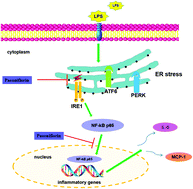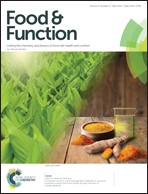Paeoniflorin prevents endoplasmic reticulum stress-associated inflammation in lipopolysaccharide-stimulated human umbilical vein endothelial cells via the IRE1α/NF-κB signaling pathway
Abstract
Endoplasmic reticulum (ER) stress-associated inflammation is a critical molecular mechanism involved in the pathogenesis of endothelial dysfunction (ED). Hence, strategies for alleviating ER stress-induced inflammation may be essential for the prevention of cardiovascular diseases. Paeoniflorin (PF), a bioactive compound from Paeonia lactiflora Pallas is known for its functional properties against vascular inflammation. However, to date, PF-mediated protection against ER stress-dependent inflammation has not been identified. Herein, we investigate the protective effect of PF on lipopolysaccharide (LPS)-stimulated human umbilical vein endothelial cell (HUVEC) injury and explore its underlying mechanism. The result of the cell viability assay indicates that PF promotes the cell survival rate in LPS-stimulated HUVECs. In addition, the LPS-induced over-production of inflammatory cytokines (interleukin-6 (IL-6) and monocyte chemotactic protein 1 (MCP-1)) and ER stress markers (78 kDa glucose regulated protein (GRP78) and CCAAT/enhancer binding protein homologous protein (CHOP)) are significantly decreased by PF and the ER stress inhibitor 4-phenylbutric acid (4-PBA). The transmission electron microscopy (TEM) assay implies that the ultrastructural abnormalities in ER are reversed by PF treatment, which is similar to the protective effect of 4-PBA. Impressively, we find that the inositol-requiring enzyme 1α (IRE1α)/nuclear factor-kappa B (NF-κB) pathway is significantly activated and contributes to the progress of LPS-induced HUVEC injury by promoting inflammatory cytokine production. IRE1α siRNA, AEBSF (ATF6 inhibitor), GSK2656157 (PERK inhibitor), PDTC (NF-κB inhibitor) and thapsigargin (TG, IRE1 activator) are used to confirm the role of the IRE1α/NF-κB pathway in PF-mediated protection against LPS-induced HUVEC injury. Our findings indicate that PF has an inhibitory effect on endothelial injury. To summarize, PF might be a potential therapeutic agent to inhibit ER stress-associated vascular inflammation.



 Please wait while we load your content...
Please wait while we load your content...